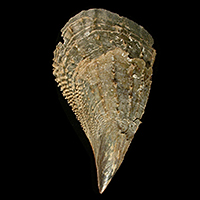|
< Previous family introduction |
|
|||||
 |
Family Pinnidae Pen, fan or razor shells
|
|||||
|
The Pinnidae is a family of large, fan-shaped shells, commonly known as pen, fan or razor shells. There are at least 50 species worldwide, but due to shell variability the number is not precisely known. They live in the tropical and temperate Pacific and Atlantic oceans, extending into NSW, plus one species restricted to southern Australia. Shells are generally 150-300 mm in length, but specimens of Pinna nobilis from the Mediterranean Sea have been recorded up to 1200 mm in length. The habitat of most pinnids is in sand or mud, with the pointed or anterior end downward, attached by a byssus to stones or shell fragments The exception is Streptopinna saccata, which nestles in coral. The byssus is extruded as single filaments by the foot, from a gland near the anterior end, hence there is small gape in the shell in that position. In life the posterior, wide end is at or above the surface of the substrate. Pinnids are very vulnerable to accumulation of sediment and fragments of the end of their shells through the widely open posterior end, but they possess two novel anatomical features that act to remove such debris – a finger-like pallial organ and a waste gutter running transversely across the mantle. In addition, the mantle is attached to the shell low down so that it is less likely to be damaged permanently than if it were close to the margin as in other bivalves. Pinnids are subject to attack by predators, including starfish and boring molluscs, and the exposed ends of the shells are frequently broken. Almost half of the shell can be broken off, but because of the low attachment of the mantle they have the ability for complete repair, leaving evidence of breaks in the shell. The Pinnidae was reviewed supposedly authoritatively by Rosewater (1961) who recognised 20 species worldwide and by Fischer-Piette (1974) with 21 species worldwide. Twenty-five years later Schultz & Huber (2013) recognised 55 species and regarded both Rosewater and Fischer-Piette as extreme ‘lumpers’. This ‘lumping’ of species has had major effects on the understanding and naming of the NSW species. In particular, Rosewater recognised the most common NSW species as Pinna bicolor, for which he gave a distribution from East Africa through the Indian and Pacific Oceans to New Caledonia, including all of Australia. But Schultz & Huber recognised Pinna bicolor as a species restricted to the Red Sea and Persian Gulf, with the NSW species consequently reverting to the name Pinna menkei Reeve, 1858. This lack of recognition of species by Rosewater has created havoc in Australian mollusc databases, with the Atlas of Living Australia showing P. bicolor distributed around all of the Australian coast except Tasmania! Iredale (1939) erected four new genera in the family, but none of them are presently accepted. They are Exitopinna, Quantulopinna and Subitopinna (now considered as synonyms of Pinna), and Servatrina (now considered as a synonym of Atrina). This work recognises five species of Pinnidae in NSW. Amongst them Pinna menkei is the most common and is restricted to eastern Australia and Atrina tasmanica has a southern Australian distribution and is found in the south of the state. A few tropical species, such as Pinna muricata, intrude into the north of the state, occasionally reaching as far south as Sydney. Family Reference Schultz, P.W.W. and Huber, M. 2013. Revision of worldwide recent Pinnidae and some remarks on fossil European Pinnidae. Acta Conchyliorum 13: 1-164. Coverage All the Pinnidae species known from NSW are treated here. Identification Notes Pinnid shells are easily placed in the family because of their large, fan shaped shells, but further identification is more difficult. Identification needs to be based on adult shells, preferable over 150 mm in length, as adult characters may not be developed in smaller shells. Allocation to genus is straightforward and is based on the interior nacreous layer; in Pinna, the nacreous layer in divided into two lobes by a longitudinal groove, which is absent in Atrina. In Streptopinna the nacreous layer is relatively small. Allocation to species in the NSW fauna is based on abundance, habitat, shell shape and texture in conjunction with distribution. Additional Species Atrina serra (Reeve, 1858) Iredale & McMichael (1962) followed by Schultz & Huber (2013) list this species in NSW, but no specimens matching this description from NSW can be located in the Australian Museum’s collection. Pinna deltodes Menke, 1843 Scheltema (1983) reported two specimens from NSW, but neither can be located, and no other NSW specimens have been identified in the Australian Museum’s collection.
|